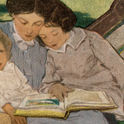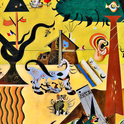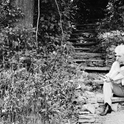It is July, 1809. The “peripatetic antiquarian” Charles Kirkliston Gibb arrives at the front door of Thomas Milne’s grand house in Glen Conach, a sparsely populated region to the north of Forfar and Dundee. Milne—better known as Baron Glen Conach, the wind-swept laird who doesn’t believe in either hats or haircuts—owns the Book of Conach, a rare 12th-century Latin tome that details the legend and pilgrimage of Saint Conach, the glen’s namesake who made his hermitage there in the 8th century. Officially, Gibb wants to translate the book into English; but in reality he is a lifelong swindler: “my particular interest is in anything that may win me a few nights’ or a few weeks’ bed and board,” he writes in his journal. And so begins James Robertson’s atmospheric new novel News of the Dead.
Except that it doesn’t begin there. It starts instead in the present day, with Maja, an elderly resident of the glen who is visited by a local boy called Lachie Darroch, who tells her that he might have seen a ghost. The revelation prompts Maja to reflect on her own long life. Meanwhile, back at home Lachie’s parents find an old journal, which they soon learn was penned in the early 19th century—by one Charles Kirkliston Gibb.
Such coincidences and parallels span all three main narrative strands of Robertson’s novel: Maja’s reflections, entries from Gibb’s journal and excerpts from Gibb’s questionable translation of the Book of Conach. As we pinball back and forth between them—as well as the growing number of sub-narratives they spawn, like Russian dolls—each strand makes its own claim to the truth; each claim, in turn, is undermined by another.
Since the publication of his first novel, The Fanatic, in 2000, Robertson has become one of Scotland’s most distinctive writers, with a career spanning short stories, novels and a Scots language publishing imprint. Throughout he has pushed back against the idea that Scotland is a static place, only “delightful to live in but nothing to write about.” In his work, Scotland emerges instead as a place constantly changing in subtle but fundamental ways. Throughout his novels we are always playing catch-up with—and trying to make sense of—what has already occurred. His Booker-longlisted The Testament of Gideon Mack is framed as the dubious account of one irreligious kirk minister’s life, discovered shortly after his strange disappearance; the panoramic And the Land Lay Still looks at six decades of Scottish society on the eve of devolution and a new century. In News of the Dead we are presented with a similar retrospective quandary—this time about the act of storytelling itself.
Glen Conach is not a real place, but closely based on Glen Esk, in the north of Angus; Saint Conach and Charles Gibb are likely modelled on the infamous case of the made-up epic poet Ossian, as propagated by James Macpherson in the late-18th century. (Robertson gives more than one nod to Ossian himself in the book.) These are in turn blended with real historical events—including the Napoleonic Wars and the continued fallout from the Jacobite uprisings. One of Robertson’s skills as a novelist is to make both events real and imagined feel equally convincing.
But after that things get trickier to decipher. Did Saint Conach ever really exist, even in this setting? Straightaway alternative origins of the word “Conach” are presented to the reader, attributing it variously to Irish legend (like Ossian) or commonplace words from Gaelic and Scots. Gibb’s dubious motives colour our reading of his translation, which already contains the sort of fantastical miracles you’d expect of any hagiography, such as the resurrection of dead animals and the curing of a young woman’s blindness. Meanwhile, in the present day, Maja is pestered by a University of Edinburgh academic called Matthew Tybault. Tybault’s research concludes that even Gibb’s recently unearthed journal—his candid attempt “to be honest even when writing of my own dishonesty”—is not entirely what it claims to be.
While it is the echo of Saint Conach’s legend across three different centuries that provides the novel with its binding intrigue, it is really Gibb who holds our attention the longest. As he ingratiates himself further with the Milne household, he soon discovers that he has stumbled upon far more than just a summer retreat and a gateway to “years of good living”: there are a whole host of personalities for him to contend with. There are Baron and Lady Glen Conach—perhaps Robertson’s most brilliantly realised foils, said to “resemble the figure 10” when standing side by side—who wait every day to hear news of their son, Sandy, who is away fighting in the war against France. Their daughter at home, Jessamine, seems condemned to the life of a spinster. In amongst this crowd Gibb has unwittingly inserted himself as both surrogate son and potential suitor.
It may be that some of Gibb’s observations of the Milnes and other residents of the glen—like the school dominie Daniel Haddow or kirk minister John Dunning—make their way into his translation of the Book of Conach. Whatever the case, Gibb’s refuge does force him into some kind of honest living for once; in the end his act as antiquarian goes far enough for him to complete his translation, however ill-intended.
Robertson is not particularly focused on writing stories that can be neatly tied up—rather he is much more interested in the various ways that stories might unravel. Gibb’s fate is never conclusively revealed. The corruption of Saint Conach’s life through Gibb’s translation leaves his story in an even more fragile state, with no sense of where the real miracles begin and where artistic licence takes hold.
In one of the early chapters of the book introducing us to Glen Conach, Robertson quotes the Scottish father of geology, James Hutton, who wrote: “with respect to human observation, this world has neither a beginning nor an end.” If after reading News of the Dead it can be said that anything is true at all, it’s that—and that Robertson may have fashioned a way of storytelling, with neither beginning nor end, that gets that bit closer to our multifarious experience of the truth.












